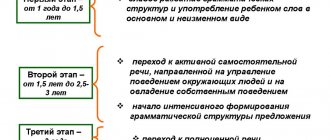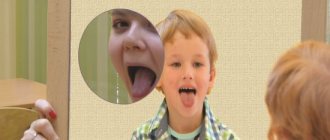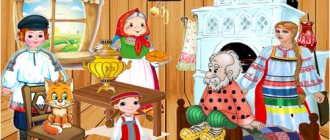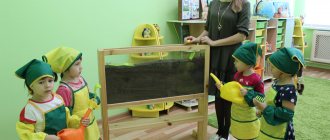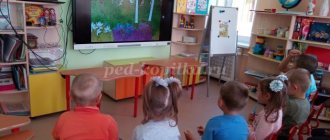“Verbal games for children 6-7 years old” card index for speech development (preparatory group) on the topic
Word games 6 – 7 years old A.K. Bondarenko Word games 6 – 7 years old A.K. Bondarenko
"Answer quickly"
Purpose of the game. Strengthen children's ability to classify objects (by color, shape, quality), teach them to think quickly and answer.
Progress of the game.
The teacher, holding a ball in his hands, stands in a circle with the children and explains the rules of the game: “Now I will name a color and throw the ball to one of you. The one who catches the ball must name an object of this color, then he himself names any color and throws the ball to the next one. He also catches the ball, names the object, his color, etc.
“Green,” says the teacher (takes a short pause, giving the children the opportunity to remember green objects) and throws the ball to Valya. “Leaf,” answers Valya and, saying “blue,” throws the ball to Vita. “The sky,” Vitya answers and says “yellow,” throwing the ball to the next one. The same color can be repeated several times, since there are many objects of the same color.
The main feature for classification may not be the color, but the quality of the item. The beginner says, for example: “Wooden,” and throws the ball. "Table", -
The child who caught the ball answers and offers his word: “Stone.” “House,” answers the next player and says: “Steel.” - "Spoon". Etc.
Next time, the main feature is the form. The teacher says the word “round” and throws the ball to anyone playing. “Sun,” he replies and names another shape, for example “square,” throwing the ball to the next player. He names a square-shaped object (window, book, scarf) and suggests some form. The same shape can be repeated several times, since many objects have the same shape.
When repeated, the game can be complicated by offering to name not one, but two or more objects.
“Who can name more actions?”
Purpose of the game. Teach children to relate people’s actions to their profession, activate their vocabulary, and develop the ability to think quickly.
Progress of the game.
Before the game, the teacher conducts a short conversation, clarifying the children’s understanding of the words “profession” and “actions”: “Children, I work as a teacher in a kindergarten. This is my profession. Tolina’s mother treats the sick. Her profession is called "doctor". What do you think is the profession of Antonina Vasilievna, who cooks dinner for us? (Children answer: “Cook.”) Name what professions you know. (Children call: “Driver, teacher, shoemaker, pilot, etc.”) Every person, having a profession, works and performs some actions. What does a cook do? (Children answer: “Cooks, bakes, fries, grinds meat, peels vegetables, etc.”) Now we will play with you the game “Who can name the most actions?” I will name a profession, and you will remember all the actions of a person in this profession.”
The teacher says the word “doctor”. The children answer: “Examines patients, listens, treats, gives medicine, gives injections, operations.” “Tailor” - bastes, cuts, flogs, irons, tries on, sews, etc.
The teacher names professions familiar to the children: janitor, nanny, laundress, driver, etc. Children remember what people in these professions do.
Whoever names the most actions is considered the winner.
"Not really"
Purpose of the game. Teach children to think, pose questions logically, and make correct conclusions.
Progress of the game.
Option 1. The teacher tells the children the rules of the game and explains the name. “Why is this game called that? Because you and I can only answer the driver’s questions with the words “yes” or “no.” The driver will go out the door, and we will agree on what object in our room we will wish for him. He will come and ask us where the item is, what it is, and what it is needed for. We will answer him with only two words. First, I will be the driver. When I leave the room, Vova will tell you what object he proposes to wish for. Then you will call me.
The teacher leaves, then enters the room and asks: “Is this object on the floor?” - "No". “On the wall?” - “No.” "On the ceiling?" - "Yes". "Glass? Does it look like a pear?” - "Yes". "Bulb?" - "Yes".
Taking on the role of the first leader, the teacher teaches children to ask questions logically. He explains: “Children, did you notice how I asked? First I found out where the object was, and then I found out what it was. Try to guess the same.”
This game teaches children to think logically: if an object is not on the floor, then it can be on the wall or ceiling. Children do not immediately draw the right conclusions. It happens like this: having learned that this object is not on the floor, the child continues to ask: “Table?”, “Chair?” In such cases, the teacher helps the child come to the correct conclusion: “Ira, we told you that the object is not on the floor. Where is the chair, the table?” - "On the floor". “Should I have named them?” - "No". “You found out that the object is on the wall. Look at the objects on the wall and guess what we wished for,” the teacher suggests. “Is it square?” - “Yes.” “Framed?” - "Yes". “Does it have flowers on it?” - "Yes". "Painting?" - "Yes".
Option 2. It is better to offer a more complex option. The teacher makes a guess for an object that is located outside the room: “Children, there are a lot of objects, and it will be difficult to guess if you don’t know whether it is on earth or in the sky, in the house or on the street, whether it is an animal or a plant.”
If children have played this game several times, they quickly begin to select questions and guess the intended object. For example, the children wished for the sun. Misha the guesser asks the following questions: “In the house? On the street? In the garden? In the forest? On the ground? In the sky?" Upon learning that the object is in the sky, 011 asks the following questions: “Air? Clouds? Snow? Sparrows? Rocket? Airplane? Sun?"
Based on his questions, one can trace the course of logical thinking: having learned that an object is in the sky, he names only those objects that can be there.
“Who will notice more fables?”
Purpose of the game. Teach children to notice fables, illogical situations, and explain them; develop the ability to distinguish the real from the imagined.
Progress of the game.
Children sit down so that they can put chips on the table. The teacher explains the rules of the game: “Children, now I will read you Korney Chukovsky’s poem “Confusion”1. There will be many fables in it. Try to notice and remember them. Whoever notices a fable by placing a chip will notice another fable - put a second chip next to it, etc. Whoever notices more fables will win. You can put down the chip only when you yourself have noticed the fable.”
First, a small part of this poem is read. The poem is read slowly, expressively, places with fables are emphasized. After reading, the teacher asks the children why the poem is called “Confusion.” Then the one who put aside fewer chips is asked to name the fables he noticed. Children who have more chips name those fables that the first responder did not notice. You cannot repeat what has been said. If the child has placed more chips than fables in the poem, the teacher tells him that he did not follow the rules of the game and asks him to be more attentive next time. Then the next part of the poem is read. It is necessary to ensure that children do not get tired, since the game requires a lot of mental effort. Having noticed from the children’s behavior that they are tired, the teacher must stop playing. At the end of the game, you should praise those children who noticed more fables and explained them correctly.
“What does anyone need?”
Purpose of the game. Exercise children in the classification of objects, the ability to name objects necessary for people of a certain profession.
Progress of the game.
The teacher reminds the children of the game “Who can name the most actions?” He says: “In this game you named what actions a person of a particular profession performs. And today we will remember what people of different professions need to work. I will call the person by profession, and you will tell me what he needs for his job.” "Shoemaker!" - says the teacher. “Nails, a hammer, leather, boots, boots, a car, a paw,” the children answer.
The teacher names professions familiar to the children of this group: doctor, nurse, teacher, nanny, janitor, driver, pilot, cook, etc.
If children do not lose interest in the game, you can offer the opposite option. The teacher names objects for the work of people of a certain profession, and the children name the profession.
“He reads, talks, teaches how to draw, sculpt, dances and sings, plays,” says the teacher and throws the ball to one of the players. “Teacher,” he answers and throws the ball to her.
In this game, as in other games where the rules provide for the ability to respond quickly, it is necessary to remember the individual characteristics of children. There are slow children. They need to be taught to think faster, but this should be done carefully. It is better to call such a child to answer first, since at the beginning of the game there is a large selection of words. The teacher encourages the child with the words: “Vitya quickly found the right word. Well done!" It is the speed of response that is emphasized.
"Hunter"
Purpose of the game. Exercise children in the ability to classify and name animals, fish, birds, etc.
Progress of the game.
Somewhere in a free space at one end of the yard or area there is a group of people playing. This is home. At a distance of several steps from the house - the farther the better - some kind of mark is placed and a line is drawn. This is a forest where different animals live. The hunter, one of the players, goes to this forest. Standing still, he says the following words: “I’m going into the forest to hunt, I will hunt for...” Here he takes a step forward and says: “... a hare”; takes the second step: “...by the bear”; takes the third step: “...like a wolf”; fourth step: “...fox”; fifth: “...a badger...”. With each step the hunter names an animal. You cannot name the same beast twice. You can’t name birds either, but if you play bird hunt, you only need to name birds.
The winner is the one who reaches the forest, naming a new animal with each step. The one who could not do this returns home, and the next one goes hunting. The unsuccessful hunter may be allowed to go hunting again. Perhaps this time the hunt will be successful.
Note. Based on the principle of this game, you can play the game “Fisherman”. The game is played the same way. The fisherman says: “I’ll go fishing and catch... pike, crucian carp, perch,” etc.
"Come up with a proposal"
Purpose of the game. To develop speech activity and quick thinking in children.
Progress of the game.
Children and teacher sit in a circle. The teacher explains the rules of the game: “Today we will come up with sentences. I will say a word, and you will quickly come up with a sentence with this word. For example, I will say the word “close” and give Misha a pebble. He will take a pebble and quickly answer: “I live close to the kindergarten.” Then he will say his word and pass the pebble to the person sitting next to him.” The word in a sentence must be used in the form in which the person guessing suggests it. So, in turn (in a circle), the pebble passes from one player to another. If children find it difficult to answer, the teacher helps them. This game is played after children have become familiar with the word and sentence.
"Say it differently"
Purpose of the game. Teach children to choose a synonym - a word that is close in meaning.
Progress of the game.
The teacher says that in this game the children will have to remember words that are similar in meaning to the word that he names.
“Big,” the teacher suggests. Children name words; “Huge, large, enormous, gigantic.”
“Beautiful” - “Pretty, good, beautiful, charming, wonderful.”
“Wet” - “Damp, damp.” Etc. When preparing for the game, the teacher selects words in advance that have a number of synonyms. It is better to write down these words so as not to remember them for a long time, since the game takes place at a fast pace.
The teacher can, by analogy with this game, develop other games, for example: he names some noun, and the children select suitable epithets for it. So, for the word “sea,” children select the epithets “calm, stormy, quiet, azure, menacing, stormy, beautiful, southern.” The child who remembers more words should be praised.
All these games can be played during a lesson in your native language (as part of the lesson).
"Choose a word"
Purpose of the game. To develop children's intelligence and the ability to select words that have the right meaning.
Progress of the game.
The teacher, addressing the children, asks them questions, for example: “Remember what you can sew.” Children's answers. “Dress, coat, sundress, shirt, boots, fur coat, etc.” “Darn?”—“Socks, stockings, mittens, scarf.” “Should I tie it?” - “Shoelaces, string, scarf, ties.” “Pull up?”—“Hat, scarf, hat, Panama hat, peakless cap, cap, Budenovka.” “Should I wear it?”—“Coat, dress, stockings, fur coat, raincoat, skirt, sundress, tights.”
The teacher names the words he has previously planned. Children give answers by choosing words that match their meaning.
"Make no mistake"
Purpose of the game. Develop quick thinking, consolidate children's knowledge of what they do at different times of the day.
Progress of the game.
The teacher conducts a conversation with the children, consolidating their knowledge about different parts of the day. Children remember what they do in the morning, afternoon, evening, and night. Then the teacher offers a game: “Children, now let’s play with you like this. I will name one word, part of the day, and you will remember what you are doing at that time. For example, I will say the word “morning”. What do you call it? Children remember: “We wake up, say hello, wash, brush our teeth, comb our hair,” etc. “That’s right,” says the teacher. - But during the game, only the one to whom I place the cube will answer, and only one action can be named (“I’m going to kindergarten” or “doing gymnastics” or “working out”); The person who calls passes the cube to another player. If someone does not remember and does not say anything, he must hit the cube on the table and pass it on. Then he is considered a loser. Be careful, don’t make a mistake!”
The teacher names different parts of the day, the children answer.
The same game can be played differently. The teacher names various actions of the children, and they must answer with only one word: day, morning, night, evening. For example, the teacher says: “I’m having breakfast,” and puts a cube to the player. He quickly answers: “In the morning.” Teacher: “I’m watching TV.” Children can name two words: “Day”, “Evening”.
"Kuzovok"
Purpose of the game. Develop auditory attention; activate vocabulary, thinking; develop intelligence.
Progress of the game.
The presenter shows the “box” and says: “This is a magic box, we will put all the words that end in “-OK” there, I’ll put a bag of apples in the box, and what will you put in the box?” Next, the “body” is passed around the circle and each player names a word ending in -ok; if the word is named correctly, the player takes a chip for himself. The one who collects the most chips wins.
“Only this letter.”
Purpose of the game: To consolidate children’s knowledge of letters and sounds; cultivate auditory attention and speed of reaction to words.
Progress of the game.
Everyone chooses one of the letters - A, B, C, D, D and so on. When everyone has their own letter, the teacher turns to one of the players and asks: “What is your letter?” - A. And for all the following questions, this player can select answers only to the letter “A”. You need to choose quickly, without hesitation.
The teacher asks: - What is your name? - Andrey. - What is your last name? - Azbukin. - Where did you come from? — From Arkhangelsk. - Where are you driving? - To Astrakhan. —What will you go there with? - By bus. - What grows there? - Watermelons. - And what else? - Apricots. — What kind of birds are there? - Storks. - What animals? - Argali. - Who will meet you at home? - Alyosha. - What will you bring him as a gift? — An album (or a diamond, or an aquarium, or an atlas, or anything else, but it must be A).
Then the teacher turns to another letter and asks it similar questions. -What is your letter?
It also happens that the one who must name all the words starting with the letter “A”, when asked: “What is your name?” - will say his own name: Sasha or Natasha, or will make a mistake in the name of the city, the country where he is going, or a tree, flower, bird. Then all the players stomp their feet or snap their fingers three times.
And when they hear the correct answer, they quickly clap their hands three times. Well, what should you do if a letter is wrong a second time? Then this letter is forced to do something: either jump around the table on one leg, or sit under the table and shout “crow” three times, or put a paper cap on its head and sit in this cap until the other one makes a mistake: then the cap put on that one. They play until all the letters answer.
Superfluous word
You can also play - name some groups of words and guess who is the odd one out. What is significant is that there can be several correct answers in this game. You can play it on the go; encourage your child to come up with such riddles. But it is important that he explains his decision. For example, I can say: “bus, tractor, trolleybus, tram.” Which of these words is redundant? Some might say bus because it starts with "A" and all the others start with the letter "T." Someone will say that it is a tram, because it is the only one that runs on rails, and everyone else does not. Someone will say that it is a tractor, because it is not public transport, and all the others carry people. Do you understand, right? Any explanation is good. It is important that it is also useful for the child to come up with such problems. After all, only adults are always the bearers of the ultimate truth: first you make a wish, then the child. And this is not only a game, but also a communication process. If you like to make things up, that's great.
Continue the word
Option 1. Two people play. The first one says half of any word, the second one must continue it and say the whole word. For example:
First: “Re..”
Second: “...rights. Horus..."
First: “od... Udo...”, etc.
The winner is the one who can hold on without stumbling.
Option 2. Game for the company. Participants are divided into 2 teams, three minutes are timed and during this time the teams must come up with as many words as possible from the beginning syllable. The team with the most words wins. For example, you need to come up with a continuation of part of the word “com...”: communism, utility worker, room, combine, company, comedian, team, etc.
Hidden letters
I think of a letter, and then the children offer words, and I say whether this letter is there, and if so, how many times it appears. For example, they say: - Cat. I answer: - There is no such letter, not a single one. The children continue: - Mountain. I confirm. - One. They say: - Pineapple. Me: - Not a single one. They say: - Fish. I :− One. And then they can already guess what letter it could be. For example, now I wished for “R”. Or you can ask the child to wish for a letter, and then it will be his turn to try to understand which letters are there and which are not. And this is a pretty serious analysis.
Author: Zhenya Kats, teacher, author of the method of game-based teaching for children. Series of online lectures “Game and Children”
Watch the free open lesson “Play and Children” with Zhenya Katz.
This may be interesting to you
Composing
This funny game, if you catch a wave of inspiration, will greatly amuse its participants. The task is simple: the first player pronounces the first phrase of the verse, the second - the next, and so on. The most important thing is to follow the rhyme. For fun, you can write down the work that the writers produce.
You can make this game easier by giving everyone a word that rhymes with their neighbor's word. Then there will be no tension with coming up with a rhyme: everyone composes the “filling” of the line. For example, from the words: love-carrots, tears-roses, you can get the following poem:
I have love in my heart
Grows like a carrot.
That's why I shed tears -
For watering a cute rose.
Decipher the song
The presenter leaves the hall, everyone makes a wish for a famous song. When the presenter enters, he must, by asking any questions (not related to the song), understand what the participants wished. Each participant must insert one word from the song into their answer. The next leader becomes the player on whom the song was recognized.
For example, the song “Oh, the viburnum is blooming in the field by the stream”:
Host: What's the weather like today?
Player 1: Oh, it looks like it's going to rain.
Host: What did you have for breakfast today?
Player 2: A sunflower is blooming under my window, I ate the seeds from it.
Host: What color is your shirt?
3rd player: If you compare the color of my shirt with the plants, it will be about the same as viburnum. And so on.
It is important to make such sentences that the presenter will not immediately guess what song they are talking about.
You cannot change the case, number, declension, or conjugation of words: they must remain in the form in which they appear in the song.
Find the color
This is a game of speed. The presenter writes the names of the players on a piece of paper and for each quick answer puts a point next to the name of the answerer. The task of the participants is to find and show the color chosen by the presenter as quickly as possible (in household items, clothing, nature, etc.) in the immediate environment.
A more complicated version of the game: guess colors with shades, for example, light green, dirty pink. You can also guess rarely spoken names of colors: lilac, olive, khaki, etc.
For schoolchildren, such a game in English or another language that they are studying will be useful.
